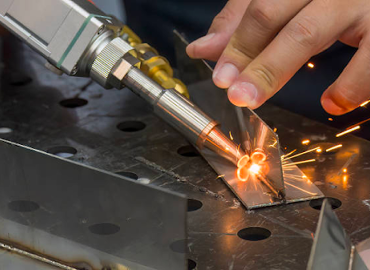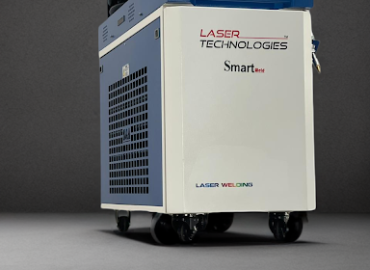Table of Contents
1. Introduction
2. What is a Laser welding machine?
3. What Is the Origin of Laser Welding?
4. How Does Laser Welding Work?
5. How Important Is Laser Welding?
6. What Is the Purpose of Laser Welding?
7. What is Laser Welding Good For?
8. What Is the Process of Laser Welding?
9. Different types of laser welding machines
10. What Types of Lasers Are Used in Laser Welding?
11. How Does Laser Power Affect the Welding Process?
12. How Does Laser Speed Affect the Quality of Laser Welding?
13. What Are the Applications of Laser Welding?
14. What are the Advantages of Laser Welding?
15. What Are the Limitations of Laser Welding?
16. What Safety Precautions are Important When Laser Welding?
17. Maintenance and troubleshooting of laser welding machines
18. The latest trends in laser welding technology
19. Conclusion
20. Key Takeaways
Introduction
In the ever-evolving world of manufacturing and construction, precision and efficiency are the cornerstones of success. One technology that has revolutionized these industries is the laser welding machine.
Welding, the process of joining two materials together, has come a long way from its humble beginnings. Traditional methods, such as gas welding and arc welding, have served their purposes for decades. However, as industries demanded higher precision and faster production rates, a need for more advanced technology arose. This need gave birth to the laser welding machine.
What is a Laser Welding Machine?
A laser welding machine is a specialized piece of equipment used in manufacturing and construction processes to join or weld materials with high precision and efficiency. It uses the power of focused laser beams to create strong, durable, and precise welds.
What Is the Origin of Laser Welding?
Laser welding, as a technology, has its origins in the mid-20th century and is a product of rapid advancements in the field of lasers and materials science. The term "laser" stands for "Light Amplification by Stimulated Emission of Radiation." Albert Einstein first proposed the idea of the laser in 1917, but it took several decades for the technology to become a reality.
Shortly after the invention of the laser, scientists and engineers began to explore its potential applications. One of the earliest applications they investigated was using lasers for welding. Early experiments showed promise, as lasers could deliver focused and intense energy to materials, allowing for precise and controlled welding.
The industrial adoption of laser welding started in the 1960s and 1970s. Initially, it was primarily used for cutting and drilling applications. However, as laser technology advanced and became more accessible, its potential for welding became increasingly evident.
How Does Laser Welding Work?
Laser welding uses the power of focused laser beams to join metals and thermoplastics. The process involves directing a highly concentrated laser beam at the exact point where the materials need to be joined. This intense energy generates heat, melting the materials.
How Important Is Laser Welding?
Laser welding is of paramount importance in modern manufacturing and construction industries, playing a pivotal role in a variety of applications. Its significance lies in its ability to offer precision, efficiency, and versatility that traditional welding methods often struggle to match. Here are key reasons why laser welding is exceptionally important:
1. Precision
Laser welding excels at providing pinpoint accuracy. It allows for the creation of extremely fine and intricate welds, even on delicate and small components. This precision is vital in industries like electronics and medical devices, where minute details matter significantly.
2. Minimal Heat Input
Laser welding produces minimal heat input, unlike traditional welding methods that can generate substantial heat and create a large heat-affected zone (HAZ). This property is crucial when working with materials that are sensitive to heat, as it minimizes the risk of distortion or damage.
What is the Purpose of a Laser Welding Machine?
Laser welding aims to join or fuse materials with a high degree of precision, efficiency, and control. Laser welding serves several important purposes in various industries and applications:
1. Speed and Efficiency
Laser welding is exceptionally fast, making it ideal for applications where rapid production is crucial. Its efficiency helps meet tight production schedules and reduce manufacturing costs.
2. Material Conservation
The precision and minimal heat input of laser welding reduce material waste. This is significant in industries that work with expensive or scarce materials, as it conserves resources and reduces environmental impact.
What is Laser Welding Good For?
Laser welding is exceptionally versatile and finds utility in a wide range of applications across various industries. It excels in several areas, making it suitable for specific tasks and materials. Here's a breakdown of what laser welding is particularly good for:
1. Heat-Sensitive Materials
Laser welding generates minimal heat input, making it well-suited for materials that are sensitive to high temperatures. This is crucial for industries like electronics, where heat can damage components.
2. Thin Materials
Laser welding is excellent for welding thin materials, as it minimizes the risk of warping or distortion. It is commonly used in industries like medical devices and precision instruments.
3. High-Volume Production
For industries requiring high-volume production, such as automotive assembly lines, laser welding's speed and efficiency make it an ideal choice.
4. Custom and Small-Batch Production
Laser welding is equally valuable for custom and small-batch production due to its ability to adapt quickly to changing requirements without the need for complex tooling.
What Is the Process of Laser Welding?
The process of laser welding involves the use of a focused laser beam to join or weld materials together. This process offers high precision and control over the welding operation. Here's a step-by-step explanation of how laser welding works:
1. Generation of Laser Beam
The process begins with the generation of a highly concentrated laser beam. This is typically done using a laser source, which can be a CO2 laser, fiber laser, YAG laser, or other specialized laser types, depending on the specific application and material.
2. Focusing the Laser Beam
The generated laser beam is then directed through a series of mirrors and lenses to focus it on the precise point where the materials need to be welded. The focusing process ensures that the laser beam is extremely concentrated and has a small diameter, allowing for high energy density at the weld point.
3. Material Preparation
Before welding, the materials to be joined are prepared. This may involve cleaning the surfaces to remove contaminants, aligning the parts properly, and clamping or fixing them to ensure they remain stable during welding.
4. Initiating the Weld
Once the materials are properly positioned, and the laser beam is focused on the welding area, the laser is activated. The intense energy of the laser beam is directed at the point where the materials meet, and it rapidly heats and melts the materials at that spot.
5. Control and Monitoring
Best laser welding machines are equipped with control systems and sensors that monitor various parameters, such as laser power, beam position, and travel speed. These systems ensure the welding process maintains the desired parameters and produces consistent, high-quality welds.
Different Types of Laser Welding Machines
There are several types of laser welding machines, each catering to specific applications:
1. CO2 Laser Welding Machine
A CO2 laser welding machine employs a carbon dioxide laser beam and is ideal for welding thicker materials, such as metals.
2. Fiber Laser Welding Machine
Fiber laser welding machines are known for their high precision and are often used for welding delicate components in electronics and medical devices.
3. YAG Laser Welding Machine
YAG lasers are versatile and can be used on both metals and non-metals, making them suitable for a wide range of applications.
4. Pulsed Laser Welding Machine
The pulsed laser welding method is characterized by intermittent laser pulses, making it suitable for applications requiring minimal heat input.
Transform Your Welding Process - Explore Our Air-Cooled Handheld Laser Solutions!
What Types of Lasers Are Used in Laser Welding?
Laser welding utilizes different types of lasers, each with its own unique properties and advantages, depending on the specific welding application and the materials involved. The most commonly used lasers in laser welding are listed below.
1. CO2 Lasers (Carbon Dioxide Lasers)
Wavelength: CO2 lasers operate in the far-infrared spectrum, typically at a wavelength of around 10.6 micrometers.
Materials: CO2 lasers are well-suited for welding non-metallic materials like plastics and ceramics and certain metals, such as steel, stainless steel, and aluminum.
Advantages: They provide high power and are effective for deep penetration welding in metals. CO2 lasers are often used for thicker materials and are cost-effective for industrial applications.
2. Nd:YAG Lasers (Neodymium-Doped Yttrium Aluminium Garnet Lasers)
Wavelength: Nd:YAG lasers typically operate in the near-infrared spectrum, with wavelengths around 1.06 micrometers.
Materials: They are versatile and can weld a wide range of materials, including metals, plastics, and ceramics.
Advantages: Nd:YAG lasers offer high beam quality, making them suitable for precision welding applications. They are often used in industries requiring fine welding, such as electronics and medical devices.
3. Fiber Lasers
Wavelength: Fiber lasers operate in the near-infrared spectrum, typically with wavelengths ranging from around 1.0 to 1.1 micrometers.
Materials: Fibre lasers are highly versatile and can weld various materials, including metals and plastics.
Advantages: They are known for their high beam quality, efficiency, and reliability. Fibre lasers are increasingly popular for industrial applications because they provide consistent high-power output.
4. Disc Lasers
Wavelength: Disck lasers also operate in the near-infrared spectrum, typically with wavelengths similar to fiber lasers.
Materials: Like fiber lasers, disc lasers are suitable for welding metals and plastics.
Advantages: They offer high power and beam quality, making them efficient for both high-speed welding and precision applications.
5. Direct Diode Lasers
Wavelength: Direct diode lasers operate in the near-infrared spectrum and can have various wavelength options.
Materials: They are commonly used for welding metals, especially in applications requiring high-speed welding.
Advantages: Direct diode lasers are known for their energy efficiency and reliability. They are used in industries where cost-effective, high-speed welding is essential.
The choice of laser type depends on factors such as the material being welded, the required precision, the thickness of the materials, and the production speed. Laser welding technology continues to advance, with ongoing developments in laser sources and systems, further expanding the capabilities and applications of laser welding in various industries.
How Does Laser Power Affect the Welding Process?
Laser power plays a crucial role in the laser welding process, significantly affecting the outcome and efficiency of the weld. The power level of the laser has a direct impact on various aspects of the welding process.
1. Optimal Power
Finding the right balance of laser power is critical for achieving high-quality welds. Too much power can result in excessive heat-affected zones and potential defects, while too little power may lead to incomplete penetration and weakness.
2. Lower Power
Lower-power lasers can be more energy-efficient, which is a consideration in industries focused on sustainability and cost reduction.
3. Power and Beam Size
Laser power, in combination with the focus optics, determines the diameter of the laser beam at the welding point. This affects the intensity of the heat and the precision of the weld.
How Does Laser Speed Affect the Quality of Laser Welding Machines?
The optimal welding speed depends on factors such as material type, thickness, joint design, and the specific requirements of the welding application. Balancing welding speed with other parameters, such as laser power and focus, is essential to producing high-quality, efficient welds while minimizing the risk of defects or material damage.
What Are the Applications of Laser Welding Machines?
The versatility of laser welding machines has led to their adoption in various industries.
1. Automotive Industry
In the automotive sector, laser welding ensures the production of durable and lightweight vehicles. It is used to weld components such as exhaust systems, fuel tanks, and even airbags. The precision of laser welding reduces the risk of defects, enhancing the safety and performance of vehicles.
2. Aerospace Industry
Laser welding machines are indispensable in the aerospace industry, where every component must meet rigorous standards. They are used for joining critical components like engine parts, aircraft frames, and fuel systems. The ability to create strong and precise welds is crucial for ensuring air travel safety.
3. Electronics and Medical Devices
Laser welding is a common choice for joining tiny electronic components and medical devices. Its precision and minimal heat input prevent damage to sensitive parts, making it ideal for manufacturing microelectronics, pacemakers, and surgical instruments.
4. Jewellery and Dentistry
The art of jewelry making and the precision required in dentistry both benefit from laser welding. Jewelers use laser welding to create intricate designs, while dentists rely on it for delicate dental work, such as attaching braces or repairing dental prosthetics.
5. Construction and Architecture
In the construction and architectural industries, laser welding machines are used to join structural components, such as steel beams and columns. The resulting welds are strong and aesthetically pleasing, making them suitable for visible applications in modern building designs.
What are the Advantages of Laser Welding Machines?
The widespread adoption of laser welding machines can be attributed to their numerous advantages.
1. Precision
Laser welding offers unmatched precision, allowing for the creation of intricate and accurate welds. This precision minimizes the need for post-welding adjustments and reduces material waste.
2. Speed
Laser welding is exceptionally fast compared to traditional welding methods. The focused laser beam quickly melts and bonds materials, resulting in shorter production times.
3. Minimal Heat Affected Zone (HAZ)
Traditional welding methods often create a significant heat-affected zone, potentially compromising the structural integrity of the materials. Laser welding, with its minimal heat input, mitigates this issue, ensuring the strength of the weld.
4. Versatility
With various types of laser welding machines available, these tools can be adapted to suit a wide range of materials and applications. This versatility makes them a valuable asset in diverse industries.
5. Weld Quality
The quality of laser welds is consistently high, with minimal defects. This reliability is crucial in industries where safety and product integrity are paramount.
What Are the Limitations of Laser Welding Machines?
While laser welding is a powerful and versatile technology, it does have some limitations.
1. Material Compatibility
Laser welding works best with certain materials, primarily metals, and some plastics. Not all materials can be effectively welded using lasers.
2. Thickness
Extremely thick materials may require very high laser power, which can be cost-prohibitive and result in a large heat-affected zone (HAZ). Thicker materials may be better suited for other welding methods.
3. Reflective Surfaces
Highly reflective materials, like copper and aluminum, can be challenging to weld with lasers because they tend to reflect the laser beam.
4. Weld Depth Control
Precisely controlling weld depth can be challenging, especially in thick materials, which can limit its use in some applications.
What Safety Precautions are Important When Laser Welding Machines?
Safety is paramount when working with lasers for welding. Here are some important safety precautions.
1. Protective Gear
Operators must wear appropriate protective gear, including laser safety glasses that block the specific wavelength of the laser being used.
2. Ventilation
Adequate ventilation is required to remove fumes and particulates generated during welding.
3. Beam Control
Ensure that the laser beam is well-contained within the welding enclosure, preventing accidental exposure.
Maintenance and Troubleshooting of Laser Welding Machines
Maintenance is essential to ensuring the reliability and performance of laser welding machines. Regular maintenance may include cleaning optics, checking gas supplies, and verifying beam alignment. Troubleshooting involves diagnosing and resolving issues with the equipment or weld quality.
Latest Trends in Laser Welding Machine Technology
Here are a few of the latest trends in laser welding machine technology.
1. High-Power Fibre Lasers
Advancements in high-power fiber lasers have increased welding speeds and efficiency.
2. Automation and Robotics
Integration with robotic systems for automated welding processes is becoming more common.
3. Hybrid Welding
Combining laser welding with other methods like arc welding for improved results.
Conclusion
Laser welding machine is a versatile and valuable machine technology with numerous applications across various industries. While it has limitations and safety considerations, ongoing advancements continue to expand its capabilities, making it a vital tool for precision welding, efficiency, and innovation in manufacturing and construction processes.
Laser welding machines are advancing rapidly, offering unparalleled precision, speed, and versatility in various industries. With advancements in laser sources and improved automation, they are poised for greater efficiency and precision in the future. Their applications span automotive, aerospace, electronics, and jewelry, making them indispensable tools in modern production processes.
Key Takeaways
A laser welding machine is used to join or weld materials with high precision and efficiency.
It uses the power of focused laser beams to create strong, durable, and precise welds.
Laser welding, as a technology, has its origins in the mid-20th century and is a product of rapid advancements in the field of lasers and materials science.
Its significance lies in its ability to offer precision, efficiency, and versatility that traditional welding methods often struggle to match.
The process of laser welding involves the use of a focused laser beam to join or weld materials together.
The optimal welding speed depends on factors such as material type, thickness, joint design, and the specific requirements of the welding application.
Operators must wear appropriate protective gear, including laser safety glasses that block the specific wavelength of the laser being used.
Maintenance and Troubleshooting of Laser Welding Machines Maintenance is essential to ensuring the reliability and performance of laser welding machines.
Laser welding is a versatile and valuable technology with numerous applications across various industries.
Laser welding machines are advancing rapidly, offering unparalleled precision, speed, and versatility in various industries.






